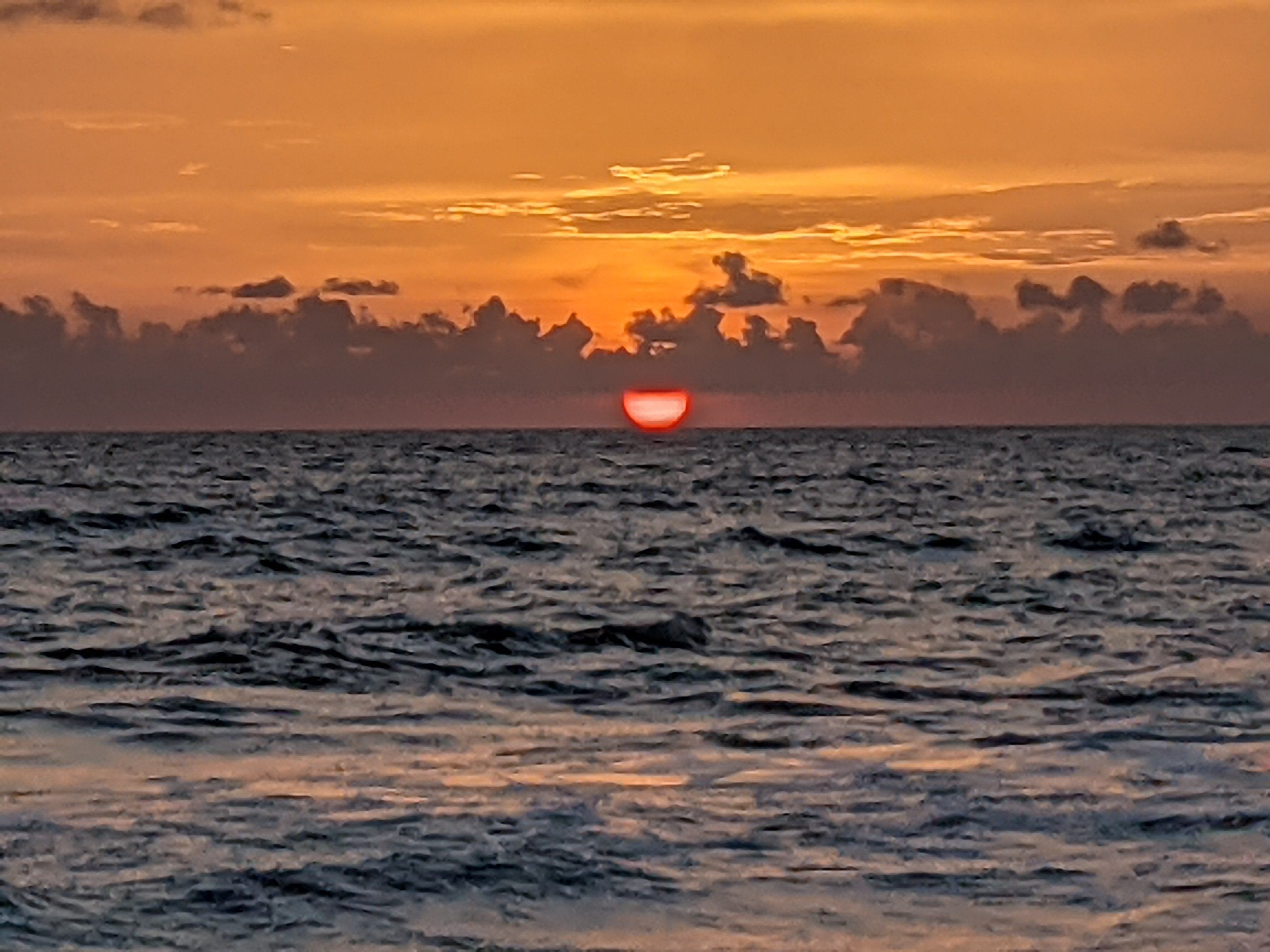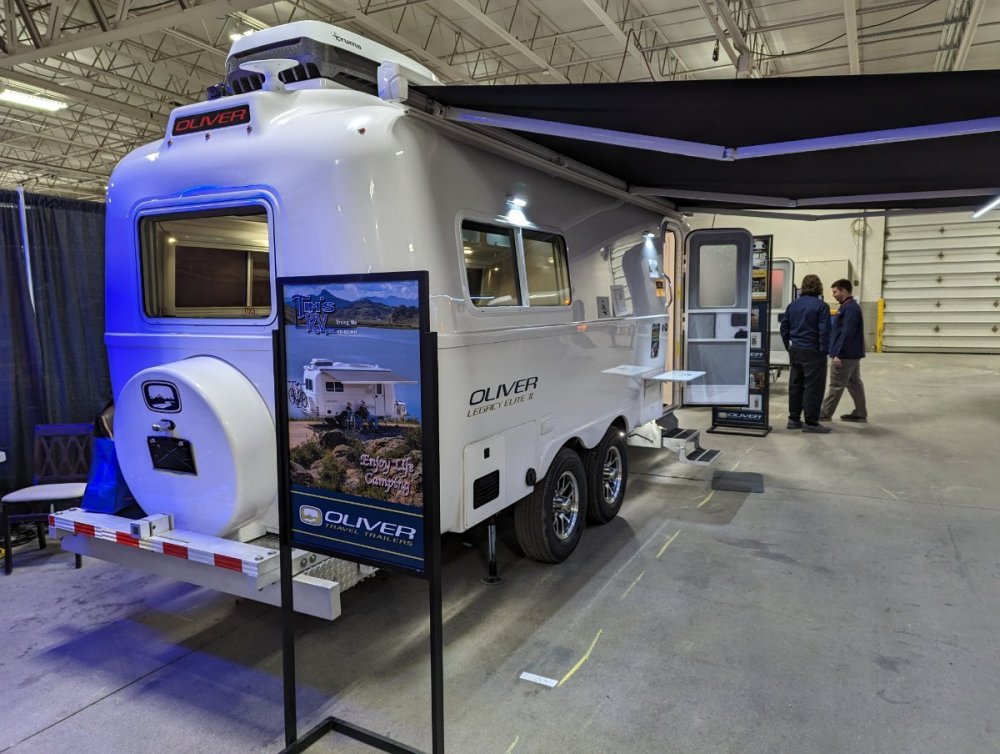-
Posts
1,045 -
Joined
-
Last visited
-
Days Won
10
Everything posted by Steph and Dud B
-
Not sure how you'd attach them to the jacks and frame.
-
Wow! Didn't even notice that!
-
One thing I haven't seen discussed much is the quietness of the Oliver cabin relative to other RVs. With the double hull and double-glazed windows our Oliver has the quietest cabin of any RV we've owned. For anyone who camps in crowded state parks, you know how loud the neighbors can get, especially on alcohol-fueled weekends. We were very pleased to discover that retreating indoors to sleep, with the windows closed, cuts off most of the noise from sound systems, barking dogs, and partiers. We've also been able to take naps in busy rest areas without being bothered by passing trucks, etc. It works in reverse, too. One evening we were watching an action movie, pretty loud, and I went outside to make sure we weren't bothering the neighbors. Turns out, I couldn't hear the movie outside the trailer. Definitely a selling point Oliver salespeople could mention.
-
The red clearance lights are required by law. The Oliver sign is not.
-
I have a question about some of the mods that add return air vents between the cabin and inter-hull spaces. Or those who open cabinet doors to warm the cabinet contents. Isn't the primary cabin insulation supposed to be the dead air space between the hulls? By creating vents that breach the inner hull, or opening overhead cabinets in cold weather, aren't you effectively removing that dead air space and becoming a single-hull unit, at just as far as insulation goes? I know my upper cabinets get cold, but I figure that is part of what's keeping my cabin warm. (The closet, OTOH, does appear to be a sealed space within the inner hull, so I don't see a problem venting that to the main cabin. Same with the bathroom. I can see adding a return vent back into the main cabin, but not between the hulls.)
-
I was surfing YouTube last night and came across a video called "Shopping for the best quality travel trailer under 30 feet." The video started with a couple standing in an Airstream on a dealer lot and I thought, "they won't even mention Oliver," but as they were showing the AS interior I could see a couple of Olivers in the distance through the AS window. The plot thickened. They moved on to a couple of stickies, talking about the advantages of having 2 air conditioners and a dry bath (the AS shower was too small for him), before walking toward an Oliver. I thought, "they're going to hate it, because it's so small." However, they redeemed my opinion of YouTubers by immediately commenting on the look and quality of the Oliver. It wasn't for them (he's 6'3"), but they really were impressed with the quality and spoke very well of the Oliver product before they moved on to an InTech, which seemed to be their favorite. I was really impressed by the dealership, which seemed to have a great assortment of RV brands to look over. How often can you find Olivers and Airstreams on the same lot? It was great to see the couple compare Olivers side by side with other brands and come away with a favorable impression. They even said, "if only it was a little bit bigger..." which is the topic of another ongoing thread... 🙂 Here's the video: https://youtu.be/LRFQ8GAqvs4?si=GPqYM6PYyyyLleH0
-

Outside Courtesy Lights
Steph and Dud B replied to Wandering Sagebrush's topic in General Discussion
If you're on shore power and your converter is working correctly (batteries stay charged, etc.) when this happens that lowers the odds it's a voltage problem, but it would still help to get a voltage reading when your furnace kicks in. You could use either a multimeter or a volts readout from a monitor in your cabin (not sure what monitors your year trailer had). Other options would include a bad connection, with the furnace observation being just a coincidence. First thing I would look at would be the switch. The contacts may be worn or oxidized, or you could have dust in there. Do the lights function correctly when switched on/off? No flickering or delay after you flip the switch? -

Outside Courtesy Lights
Steph and Dud B replied to Wandering Sagebrush's topic in General Discussion
Since they blink off when the furnace cuts in, I suspect the latter. What type of batteries do you have and what's their voltage when the furnace is running? -
I assume you mean running the 3-way fridge on 12 volts, and you have the 390Ah lithium package? You can't use the last 10% (39 Ah) from your batteries due to the low voltage shutdown, so you have 351 Ah available. We have the larger 640 Ah package. When traveling in rainy weather (no solar charging) with the 3-way Norcold fridge running on 12v, we consume approx. 4% of our state of charge per hour on warm days. Based on that, I'd assume you'd use about 7% of your SOC power per hour in the same circumstances (because of your smaller battery bank). Mid-summer SoCal gets about 14 hours of daylight, so that leaves 8 hours of minimal or no charging. 8x7 would guestimate a SOC loss of 56%/day (assuming perfect sunny weather). That's about 219 of your 351 Ah. Your solar panels theoretically generate 340 watts, or about 24 amps, but that's only in a lab environment. Let's say you can actually get about half that real-world. 12 amps averaged over the 14 hours of daylight. That would replace 168 of the 219 used. So, best case, you're losing over 51 amps a day. Too much. I don't think you'll make it, and you could permanently damage your lithium batteries. (Maybe someone with better solar knowledge can jump in here.) OTOH, 2 full propane tanks will easily run your fridge for weeks with the small amount of electricity used for the fridge control board easily replaced by solar. I'd fill my propane tanks, put the regulator on auto switchover, and leave it be.
-
Same thing here, and we have the lithium enabled Xantrex converter/inverter. Every few months it trips the 20A GFCI in the garage. No specific environmental changes that I can infer, it's just sitting there. Nothing else plugged into that circuit, either. Now I've added a small green LED nightlight on that circuit that I can see in the security camera. Every once in a while I check in to make sure it's still on.
-
Doesn't really sound particularly dangerous: "The potential defect we identified is part of the propane tank/cylinder valve assembly that could result in a leak after disconnection from the grill- but only if you forget to close the barbeque tank/cylinder valve." (Emphasis mine.) I always make sure a tank is off before disconnecting the hose.
-
I assume you're plugging into a standard household outlet and using an adapter to convert your 30A Oliver cord to that outlet? Are all three prongs present on the adapter? If you unplug the fridge from the 120v outlet located under the sink, does the house GFCI still trip when you turn on the fridge breaker? If no, the fridge has an issue. If yes, the issue is in the circuit. Does the fridge run correctly on propane? On 12v?
-
Agreed. Different class of trailer, but we did like them.
-
I see Intech Sol trailers next to the Ollies. Same dealer? The Massachusetts Oliver dealer also sells Intech Sol trailers and had them next to the Olivers at the Springfield show. Interesting side by sides with some similarities. The Sols also have aluminum frames. They have a one-piece fiberglass roof and seemed to us generally well made for conventional skinned trailers. I can see how a customer interested in a Sol might be swayed by an Oliver. And vice versa.
-

Generator Inverter Usage
Steph and Dud B replied to Wandering Sagebrush's topic in Mechanical & Technical Tips
Don't be nervous. The Yamaha will be fine. Just get the grounding plug and adjust setting #28 like @rich.dev said. I do it through the wall control panel rather than the app. I've found some odd behavior when using the app to change that setting. -

We're going to see an Oliver at a show!
Steph and Dud B replied to Steph and Dud B's topic in Events & Rallies
The salespeople need to know the product and engage. -
@Tom and Doreen, that's basically what I suspected. Energy in a campground can't be magically created, only redistributed. Those with autotransformers will be able to use more during a low voltage event than those without, until the load exceeds the overall capacity of the grid.
-
There really hasn't been that much difference in our use of the Ollie wet bath compared to the dry bath in our fifth wheel - except height. At 6', I have to bend over to wash my hair in the Ollie, which I didn't have to do in the fifth wheel, but that isn't specifically because it's a wet bath. We have the OTT-supplied shower curtain to keep the commode area dry while showering. We used to wipe down the walls of the shower enclosure in the fifth wheel just like we wipe down the shower walls in the Ollie now. Not really all that different. (The one thing I really miss was specific to our last fifth wheel. The bathroom was right next to the furnace and there was a floor heat register in the bathroom just outside the shower enclosure. You'd step out of the shower and stand right over that heat vent on cold days. Wonderful.)
-
Here's an article about some big fiberglass trailers from the past, including a 38' fifth wheel prototype (which looks very cool): https://www.theautopian.com/this-prototype-fiberglass-camper-is-a-38-foot-beast-filled-with-brilliant-ideas-that-never-made-it/
-
@CRM, what is the effect on the larger grid? I can't imagine everyone could run autoformers without some measurable increased load on the grid or we'd all have them in our houses. When using one, aren't you further reducing the amount of power available to others on the grid? I'm not saying a single RV would make much difference, but there has to be a cost somewhere.
-
This is explained well here: https://changinglanesrv.com/hughes-autoformer/ (Electricians feel free to correct my interpretation here...) Volts: electrical potential (think water stored in a tank). Amps: flow of electrical current (think water pushed through a pipe under pressure). Watts: work done by the electricity (think a water wheel at the end of the pipe). You need both volts and amps to do any work. Volts X Amps = Watts. Low voltage in the campground means you have to use more amps to do the same work, but amps generate heat in the wiring so they're limited by circuit breakers for safety. (Our Olivers are limited to pulling a maximum of 30 amps from the campground grid.) Even with an autoformer, you will never be able to pull amps (current) from the campground grid faster than the campground's pedestal circuit breaker will allow, so in that way you're no different than any other camper. However, in a low voltage situation, you will be able to get more usable power (watts) from that pedestal by jacking up the voltage in your trailer, so now you are potentially using more power than your non-autoformer neighbors. The power company bills the campground for the number of watts consumed per hour, so someone using an autoformer in a low voltage situation is costing the campground more power per hour than someone who isn't. However, you're still only using the amount of power (watts) you would have used if the campground grid was operating properly at the correct voltage, so you're not "stealing" anything. (A bigger question is, how does this affect the larger power grid? Is the campground voltage low because the utility company has less capacity than normal? If lots of campers in the campground are using autoformers could they overwhelm the entire campground grid and cause it to fail because they are using more watts than the grid is capable of supplying at that time? I assume there's a limit, correct?)
-

We're going to see an Oliver at a show!
Steph and Dud B replied to Steph and Dud B's topic in Events & Rallies
We did see the Oliver trailers in Springfield, both an LE1 and an LE2. The Olivers were displayed next to several Intek Sol trailers (which seem like decent campers). Asking price for the LE2 was slightly over $100K. Saw a couple glance at the LE2 price tag and say, "Are they crazy," so we engaged them and told them about the superior construction of the Olivers. Chatted a bit with one of the sales reps but I think we were more excited about the Olivers than he was. No Oliver family present at this show. While we were there, we did see a couple go inside the LE2 and sit down, a good sign. It was really good to see OTT represented, for sure. -

Oliver batteries not charging with generator
Steph and Dud B replied to chiwald's topic in Mechanical & Technical Tips
Excellent! Glad you are able to finish your trip. My gut feeling is you have a bad EMS unit. OTT should get you straightened out. -

Oliver batteries not charging with generator
Steph and Dud B replied to chiwald's topic in Mechanical & Technical Tips
With lithium, you need to change a Xantrex setting before trying to use a small generator. The Oliver's converter (charger) will try to draw more power than the small generator can produce. So, stick with the 3500W genny for now. Also, are these inverter-type generators? Industrial jobsite generators may not produce "clean" power. If the power is drifting in and out of spec, the Oliver's electrical management system may start rejecting/accepting that power. That could be the cause of the clicking. Are you getting error codes on the display in the attic? Next, is the 3500W inverter-type generator producing electricity when not connected to the trailer? Test it with any handy electrical device. If not, the generator's circuit breaker might have tripped. If the generator is producing power, look next to the connection between the trailer and genny. As @topgun2 mentioned, some generators (inc. Honda) require a grounding plug inserted into one the the genny 15A outlets before connecting to an Oliver. If the plug isn't present the EMS will cut the power and the display in the attic will show an error code. The clicking under the dinette might be the transfer switch if you have the optional shore line connector on the front right side of your hitch near the propane tanks. What happens if you plug into the optional front shore line connector instead of the one on the driver's side? When connected to the generator does your microwave have power?





